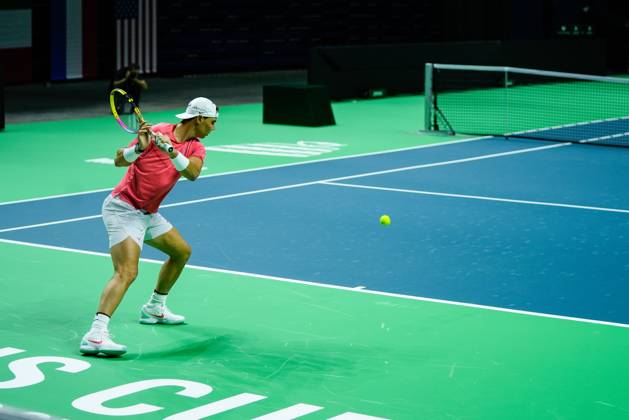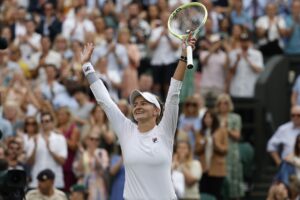The Davis Cup may literally be the biggest prize in tennis (it is so big that it is impossible for one person alone to lift it), but in recent decades it has been far from being metaphorically the biggest prize in the sport, as an increasingly congested tennis calendar has reduced the time available for it. Nevertheless, it remains uniquely significant because it allows male players to represent their country rather than just themselves, and that is as true for The Big Three of Novak Djokovic, Roger Federer and Rafael Nadal as it is for other players.
Ahead of this week’s Davis Cup finals in Malaga, which will double as Nadal’s farewell to tennis, we look back at the biggest moments for The Big Three in The Davis Cup and consider what lies ahead for Nadal as he attempts to win the Davis Cup with Spain for a fifth time. Both Novak Djokovic of Serbia and Roger Federer of Switzerland willed their countries to what is, to date, their only Davis Cup titles as nations.
Djokovic’s 2010 Davis Cup Win With Serbia: The Turning-Point
It is not hyperbole to say that Novak Djokovic’s 2010 Davis Cup win with Serbia was the turning-point in his career, but it is a statement that requires some qualification. That is because that triumph in the autumn/fall of 2010 coincided with doctors finally finding the cause of the seemingly endless injuries and ailments that Djokovic had suffered up until then, namely a gluten intolerance. One change of diet later, Djokovic led Serbia to Davis Cup victory and set himself on the road to more than a decade of domination on the ATP Tour.
Djokovic had actually won a Major prior to winning the Davis Cup, but his triumph at the 2008 Australian Open had turned out be something of a false dawn. Although it was undeniably impressive to have won his first Grand Slam Singles title in Melbourne, he did not immediately build upon it. Indeed, more than two and a half years later, when he faced France in Belgrade in the Davis Cup final, he had still only won one Major.
All that changed for Djokovic after winning the Davis Cup. The 2010 final was a classic, one of the best in the 21st century so far, as Djokovic won both his singles matches, against Gilles Simon and Gaël Monfils, but had to rely on Viktor Troicki to win the fifth and final rubber against Michaël Llodra to seal a 3-2 victory. Cue bedlam in Belgrade, with Djokovic likening the Davis Cup win to the country winning the World Cup in football. And within six weeks, after becoming gluten-free and a world champion with his country, he won his second Major, at the 2011 Australian Open, and although he never won the Davis Cup again with Serbia he would go on to win a record 24 Major Singles titles. During the 2010 campaign, Djokovic won both singles matches against the United States, a decisive result, and Serbia also defeated Croatia, and the Czech Republic.
Federer’s 2014 Davis Cup Win With Switzerland: The Final Triumph (Or So We Thought)
When Roger Federer finally won the Davis Cup with Switzerland in 2014, it appeared at that time as if it might just be the last big victory of his career. That was because he had already gone more than two years without a Major Singles title and with Novak Djokovic beginning to exert a vice-like grip on the sport’s biggest prizes, including the 2014 Wimbledon final in which he defeated Federer, it seemed possible that winning the Davis Cup with his country might just be the perfect way for the great Swiss to sign off from tennis in style.
As with any Davis Cup victory, including Serbia’s in 2010, no one man can win the Davis Cup on his own, although Andy Murray, playing both singles and doubles with his brother, came close to achieving that with Great Britain in 2015. In 2014, Federer had the more-than-able assistance of Stan Wawrinka, the compatriot who had become probably Switzerland’s best male player over the previous year after winning his maiden Major title at the 2014 Australian Open, albeit against a clearly injured Rafael Nadal.
With Federer and Wawrinka effectively constituting a two-man team (they played both singles and doubles, including in the final), Switzerland as a tennis nation was finally able to capitalise upon the greatness that Federer had exhibited for more than a decade. They defeated Serbia (albeit Serbia sans Novak Djokovic) in the first round and then went all the way to the final where, like Djokovic’s Serbia in 2010, they faced France.
The 2014 final on indoor clay in Lille was probably the sternest test ever of the theory that Federer, who was seemingly the crowd favourite wherever he went, never played an “away” fixture in his life. And with tennis-mad France desperate to win on home dirt, Federer initially stumbled, losing in straight sets to Gaël Monfils to leave the tie perfectly balanced at 1-1 at the end of the first day, following Wawrinka’s four-set win over Jo-Wilfried Tsonga.
Thereafter, however, Federer redeemed himself beautifully. First, he partnered with fellow Grand Slam champion Wawrinka in the doubles, just a week after a very public spat between the two players at the ATP Tour Finals in London, to beat Julien Benneteau and Richard Gasquet in straight sets. Then he easily defeated Gasquet in straight sets to win his second singles rubber and with it the tie and the Davis Cup itself. As he was hoisted aloft by his team-mates and support staff, even Federer himself might have thought that this was the last significant triumph of his career. But just over two years later, at the 2017 Australian Open, he began the late-career renaissance that would ultimately produce his last three Major Singles titles.
During the 2014 campaign, Switzerland won every matchup 3-2, defeating Serbia, Kazahkstan, and Italy to reach the final.
Rafael Nadal’s 2004 Davis Cup Win With Spain: The Beginning…
When he announced that he would be retiring after the 2024 Davis Cup finals, which of course are being held in Spain, Nadal himself said that it represented his career coming full circle. That was because one of the most important early achievements in his career was helping Spain to win the Davis Cup final in 2004, which was also held in Spain, albeit on the clay of Sevilla rather than the indoor hardcourt of Malaga.
Nadal had already announced himself to the tennis world before that 2004 Davis Cup final, notably by defeating Roger Federer in their first ever meeting at the Miami Open earlier that year when he was only 17 years old. However, he was yet to win his first Major (he did not compete at Roland Garros that year because of injury) and so it was really at that year’s Davis Cup final against the USA that he made his greatness evident.
That was because he defeated Andy Roddick, the former US Open champion and Federer’s greatest rival until Nadal himself fully emerged, in four sets in his first singles rubber, and that after losing the first set on a tie-break. He recovered splendidly to win the next three sets, including one on another tie-break. And although he did not play another singles rubber, he did not need to, as Spain took an unassailable 3-1 lead before the final singles rubber, with Spanish legend Carlos Moya winning two singles matches for his country. The 2004 Davis Cup saw Spain defeat, Czech Republic, Netherlands, and France to reach the final.
…And In 2024, The End
Nearly 20 years later, Nadal will be attempting to win a fifth Davis Cup with Spain this week, beginning with a quarterfinal tie against the Netherlands. Although he will only be playing doubles rather than singles because of all his recent injuries, he is still the ultimate competitor and whether he plays alongside Carlos Alcaraz, as he did at the Olympics earlier this year, or with Marcel Granollers, who rose to World No.1 in doubles earlier this year, he will have a truly formidable partner.
Perhaps what is most exciting about the 2024 Davis Cup finals is that it offers the possibility of Nadal enjoying a truly grand farewell from tennis if he and Spain can reach the final, especially if they face defending champions Italy in that final. The fact is that for all their achievements in the Davis Cup, with each one winning the tournament at least once with their country, there were only ever two Davis Cup matches between any two members of The Big Three: Federer beat Djokovic in a 2006 play-off; Nadal defeated Djokovic in the first round of the 2009 tournament; and Federer and Nadal never played each other in the Davis Cup.
By contrast, there is a real possibility of “The New Two” of Carlos Alcaraz and Jannik Sinner leading their respective countries to the Davis Cup final in 2024, in 2023 Sinner led Italy to the title. That tantalising prospect alone would make it one of the most eagerly anticipated Davis Cup finals in recent decades, but the fact that it could double as Rafael Nadal’s final tennis match ever would make it an event for the ages. Nadal was already presented with the lifetime achievement award for Davis Cup, Nadal will finish with 29 consecutive singles matches won in the Davis Cup, and 37-5 overall for singles and doubles with this tournament still pending. Nadal will play alongside the next Spanish superstar Alcaraz, and the captain of the team is the gritty legend and his longtime teammate David Ferrer. Achieving more in Davis Cup than Djokovic, Federer, or Andy Murray, Nadal led Spain to multiple Davis Cup titles.
Main Photo Credit: Imago Images Copyright: xJoaquinxCorcherox






